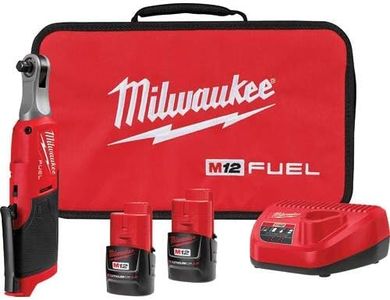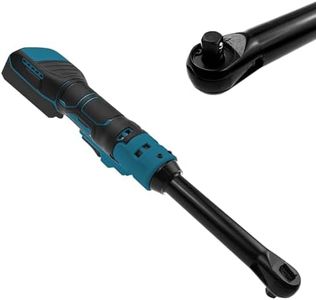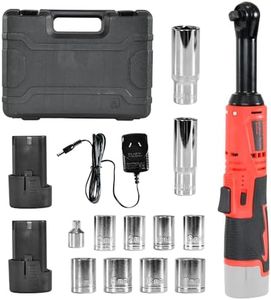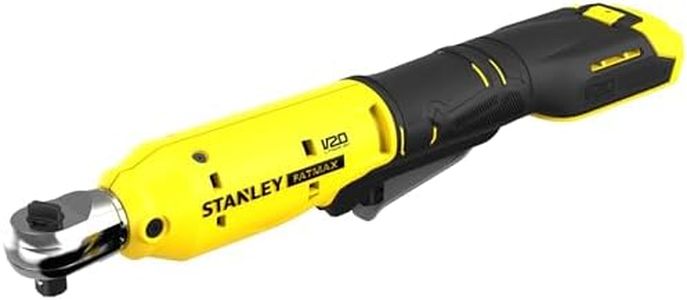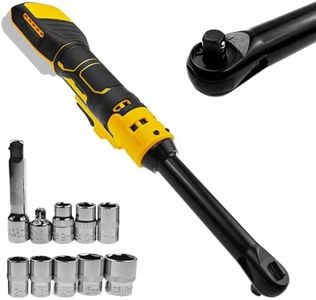We Use CookiesWe use cookies to enhance the security, performance,
functionality and for analytical and promotional activities. By continuing to browse this site you
are agreeing to our privacy policy
10 Best Electric Ratchet
From leading brands and best sellers available on the web.Buying Guide for the Best Electric Ratchet
When looking to buy an electric ratchet, it's important to match the tool with the kinds of tasks you do most often. Electric ratchets can save a lot of time and effort, especially when you're working with many bolts or in hard-to-reach places. Before buying, think about where you'll use the ratchet (at home, in the garage, or on a job site), what type of projects you expect to tackle, and how much compactness and power you need. Understanding the main features will ensure you choose a tool that makes your work easier and more efficient.Drive SizeDrive size refers to the size of the square fitting that connects to the socket. The most common sizes are 1/4-inch, 3/8-inch, and 1/2-inch. A 1/4-inch drive is best for smaller, lighter tasks and is very compact, perfect for tight spaces or delicate work. A 3/8-inch drive is the most versatile, useful for general automotive or household repairs. A 1/2-inch drive is larger and delivers more torque, ideal for heavy-duty jobs like larger bolts. When choosing drive size, consider the types of fasteners and jobs you expect to handle most often.
Maximum TorqueTorque measures the twisting force the ratchet can apply, usually given in foot-pounds (ft-lbs) or Newton-meters (Nm). Higher torque means the tool can loosen or tighten tougher, more stubborn bolts. Light-duty work usually needs around 30-40 ft-lbs, medium jobs often require 40-60 ft-lbs, and heavier bolts may demand tools with even more. Pick a torque level that matches the kind of bolts you'll encounter, but keep in mind that too much torque on delicate fasteners can cause damage.
Speed (RPM)Speed, shown as revolutions per minute (RPM), tells you how fast the ratchet turns. Higher RPM means quicker fastening or loosening, but it can be harder to control. Lower speeds make precision work easier. If you need to finish lots of bolts quickly, higher RPM is useful. For detailed or careful work, or in tight spaces, a lower speed might be better. Some electric ratchets let you control speed with a variable trigger for more flexibility.
Battery Type and VoltageMost electric ratchets are cordless and use rechargeable batteries, typically lithium-ion. Voltage (like 12V or 18V) tells you how powerful the battery is—the higher the voltage, the more powerful and long-lasting the ratchet tends to be. For light household or small automotive tasks, lower voltage is usually enough and keeps the tool lighter. For frequent or heavy-duty use, a higher voltage ensures longer operation and stronger performance. Also, consider how easy it is to recharge or swap batteries.
Head Size and ProfileThe head size and profile refer to how bulky or slim the ratchet head is. A more compact head allows you to fit the tool into awkward or tight spaces, which is often necessary in automotive or appliance work. Larger heads might be stronger but can get in the way. If you often work in confined areas, go for a slim profile; if space isn’t a big concern, a larger head might be fine.
Ergonomics and WeightHow the tool feels in your hand and the overall weight make a big difference, especially for longer jobs. A comfortable, non-slip grip can reduce hand fatigue, while a lighter tool is easier to maneuver, particularly overhead or in tricky spots. If you'll be using your electric ratchet for extended periods, or you move around a lot, prioritize comfortable ergonomics and manageable weight.

